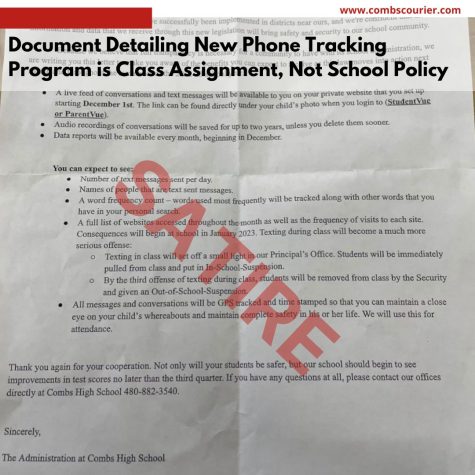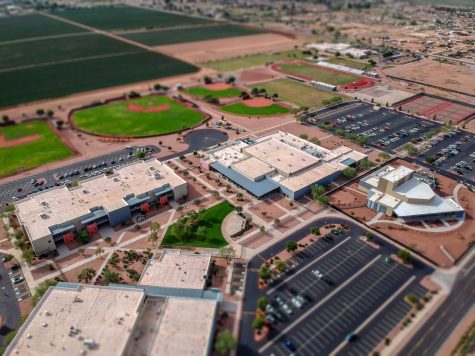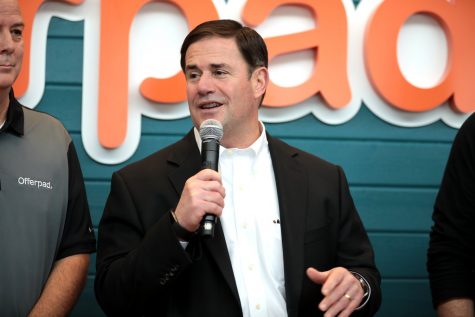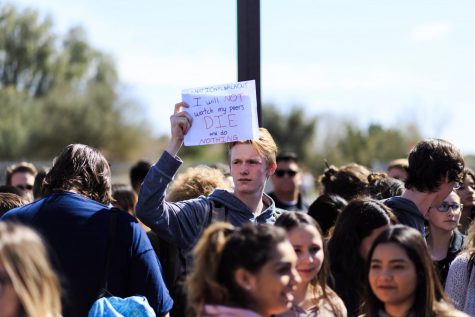Arizona Public School Districts May Have To Cut Millions From Budget If Legislators Don’t Take Action
After Arizona passed a new budget in June dedicating more than $600 million to schools in the state, public districts may have to cut over $1.15 billion from their budgets if action isn’t taken to override the Aggregate Expenditure Limit by March 1.
J.O. Combs Superintendent Gregory Wyman believes the AEL should be toward the top of the agenda for the new state legislature.
“I would say that the AEL is the number one issue facing traditional public education in Arizona right now,” Wyman said.
What is the Aggregate Expenditure Limit?
According to arizonaaea.org, ¨The Aggregate Expenditure Limit (AEL) is a Constitutional Amendment that was passed by Arizona voters in 1980 which created a spending limitation for school districts based on the aggregate expenditure of all districts.”
The intention of the AEL is to cap the spending of districts in order to limit taxes in cities and towns. Essentially the AEL limits the amount of money a district is able to spend based on the spending of all public districts in Arizona. The limit excludes charter schools.
Last year the legislature voted to override the AEL to allow for increased spending; action to override the spending cap for this year’s budget is now in debate.
What does the limit mean for the district?
With JOCUSD potentially having to cut upwards of $6 million from its budget. Superintendent Wyman has been a vocal advocate for lifting the cap.
“AZ public schools will still need a solution for this issue for the current year, next year and long term,” Wyman said.
Wyman expressed uncertainty on how the district can respond in the case of the limit remaining unlifted.
“Fixing the AEL is critical for school districts. This needs to be the number one priority for the new legislative session,” Wyman said in a recent tweet.
“Because no one’s ever gotten up to Doomsday, so to speak, nobody’s actually figured out all the intricacies of what school districts can do,” Wyman said. “A school district budget is very complex, and has lots and lots of different funds, and some funds you can use.”
There are different rules that apply to which funds can be moved around, and which can’t, meaning the district has to carefully navigate where they are allowed to shift money around.
“It’s really just about, ‘let’s come up with some plans, what the final decision would be if they don’t solve it. It’s hard because we’re talking about people’s lives, we’re also talking about kids,” Wyman said.
Wyman is concerned that even if the limit is lifted, the damage may already be done.
“Even if they do solve it, it may be in the fact that they stretched this out, they may have created a problem. Say we have four bus drivers get nervous and quit, then what do we do to these bus routes?” Wyman said.
What can be done about the Expenditure Limit?
As the next legislative session begins Monday, the expenditure limit is expected to be a priority subject. A two thirds majority vote in both the Arizona House and Senate will be needed to override the AEL. Many Democrat leaders in the House and Senate have pushed support for the lift.
“It’s a betrayal of our students and our schools. It’s also a betrayal of the legislators who voted for a less-than-ideal budget under the promise that there would be a special session to address the AEL,” said Senator Christine Marsh in a September 2022 press conference.
Some republicans have also expressed interest in lifting the cap, suggesting some bipartisan support for action.
The Aggregate Expenditure Limit Going Forward
Even if the AEL is lifted this year there is still the question of what will happen when districts come face to face with the limit in coming years.
“We’ll constantly be above this limit until we get caught up and we’ll get back down, and that just means this is an ongoing problem. Now it’s projected to be a problem unless they make a permanent change,” Wyman said.
When asked how the district will adapt going forward if forced to continue facing the AEL, Wyman compared the challenges districts may face with those of COVID.
“Was anyone prepared for COVID? No. Now, your second year or your third year of COVID you do things differently because you learned from your first and second year,” Wyman said. “If this year, they come right up to the line, then next year will count for some of the things we didn’t do this year. We will come up with a solution, but it may mean school will look different than what it currently looks like. But I can’t tell you what that looks like.”
There are two options going forward in terms of changes to the AEL. The first would be to completely amend the AEL out of the state constitution, eliminating the cap. The other option would be to make a permanent increase to the spending limit as has been done previously.
“I think currently, with the political climate in this state, it’s more viable to raise the cap,” Wyman said. “Conservatives tend to like the idea of having a cap so there’s not this potential to go hog wild and spend all this money and raise your taxes. And so therefore, that’s more palatable for the general public. If the state got to where they were purple, then I think you would probably have a different conversation.”
Regardless of the outcome of this year’s legislation, it is clear that district spending is bumping heads with the AEL process, and a conversation will need to be had about the future of it going forward before it causes significant problems.
“Some places have suggested you have to shut schools down. So you’re a spring sports start playing baseball or softball, and you just lost your season? You don’t get to walk at graduation? What about state testing? What about ACT? So the ramifications are just massive,” Wyman said.











